Small Things
First published in Sanctuary Asia,
Vol. 45
No. 10,
October 2025
“If you take care of the small things, the big things take care of themselves.”
– Emily Dickinson
Across India’s forests, coastlines, hills, even urbania, the natural world continues revealing secrets hidden in plain sight. Frogs that sing for a single night in a year, ants known from a single valley, and spiders hidden from discovery on inaccessible rocky slopes. Equipped with field notes, drones, gene maps, and now Artificial Intelligence, botanists, zoologists and vigilant citizen scientists are unearthing species at an astonishing pace. Such discoveries come with attendant urgency because they emerge from fragile, vanishing habitats, or those targeted for economic exploitation. Ironically, even as biodiversity declines,
the number of trained taxonomists seems to be diminishing.
Sanctuary’s October 2025 Cover Story explores the wonder and significance of small finds by those who use technology, taxonomy and curiosity to uncover India’s hitherto undiscovered species. And, predictably, often the smallest things harbour the most vital truths.
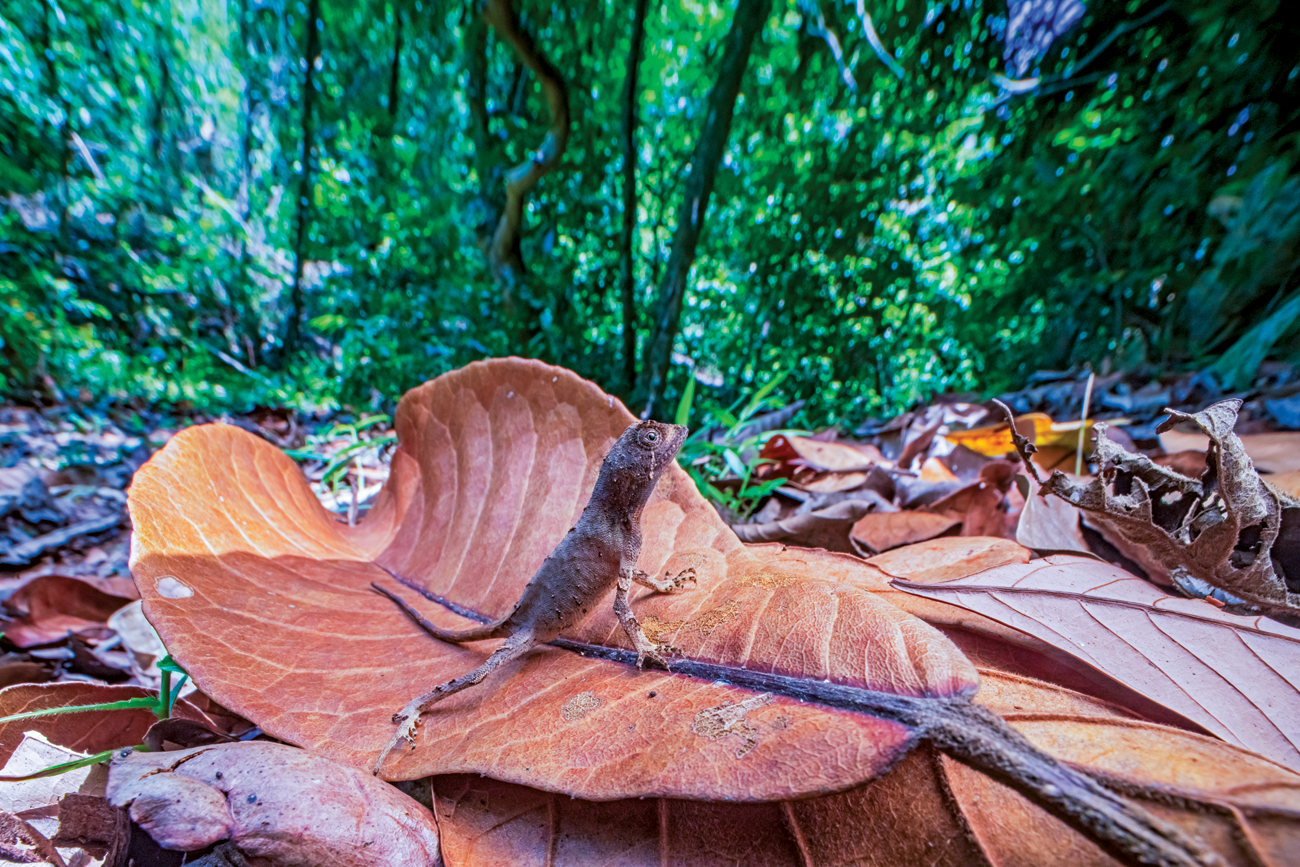
A female northern kangaroo lizard Agasthyagama edge, first spotted during researcher Sandeep Das’ work with the Zoological Society of London’s EDGE project. In honour of the programme’s global efforts to conserve Evolutionarily Distinct and Globally Endangered species, the team named the species Agasthyagama edge. Photo: Dr. Sandeep Das.
From Forest Floors to Gene Maps
The Uncovering of our Hidden Natural World
By Saurabh Sawant
One dusk in the Western Ghats I paused with a recorder in hand. Frogs chorused unseen, a babbler rustled through the leaves, and a bat skimmed silently overhead. The forest seemed timeless, yet I was aware that what I carried in my hand was part of a new frontier. Over the last decade I have recorded countless calls, at first to learn more about the birds I loved. Merlin was among the first large-scale tools to put those recordings to global use. Many of the calls fellow birders and I recorded were used to train machine learning models that now power real-time call identification for Indian species, turning the ephemeral songs of the forest into knowledge that could be shared in real time. The list grows every month, reaching more birders and communities than I could have imagined. And as I write this from the Ranthambhore Tiger Reserve, where I am training over a hundred newly recruited forest guides, I see they are already using Merlin in the field.
India is at a paradoxical moment. The last two decades have given us new frogs in the Western Ghats and Northeast, cryptic bats in the Himalaya revealed by ultrasonic detectors, orchids documented in Nagaland and Arunachal, with satellite-based habitat models beginning to guide searches in the Northeast, and the Rusty-throated Wren-Babbler brought back to notice in Arunachal Pradesh. Camera traps have given us the first robust estimates of snow leopards in Ladakh and Arunachal. And in fact a Jerdon’s Courser was recorded just this monsoon. Yet State of India’s Birds 2023 warns that nearly 60 per cent of species are in decline, with grassland birds among the hardest hit. Discovery and disappearance march together. The tools we use must not only help us find, but also give us the means to protect.
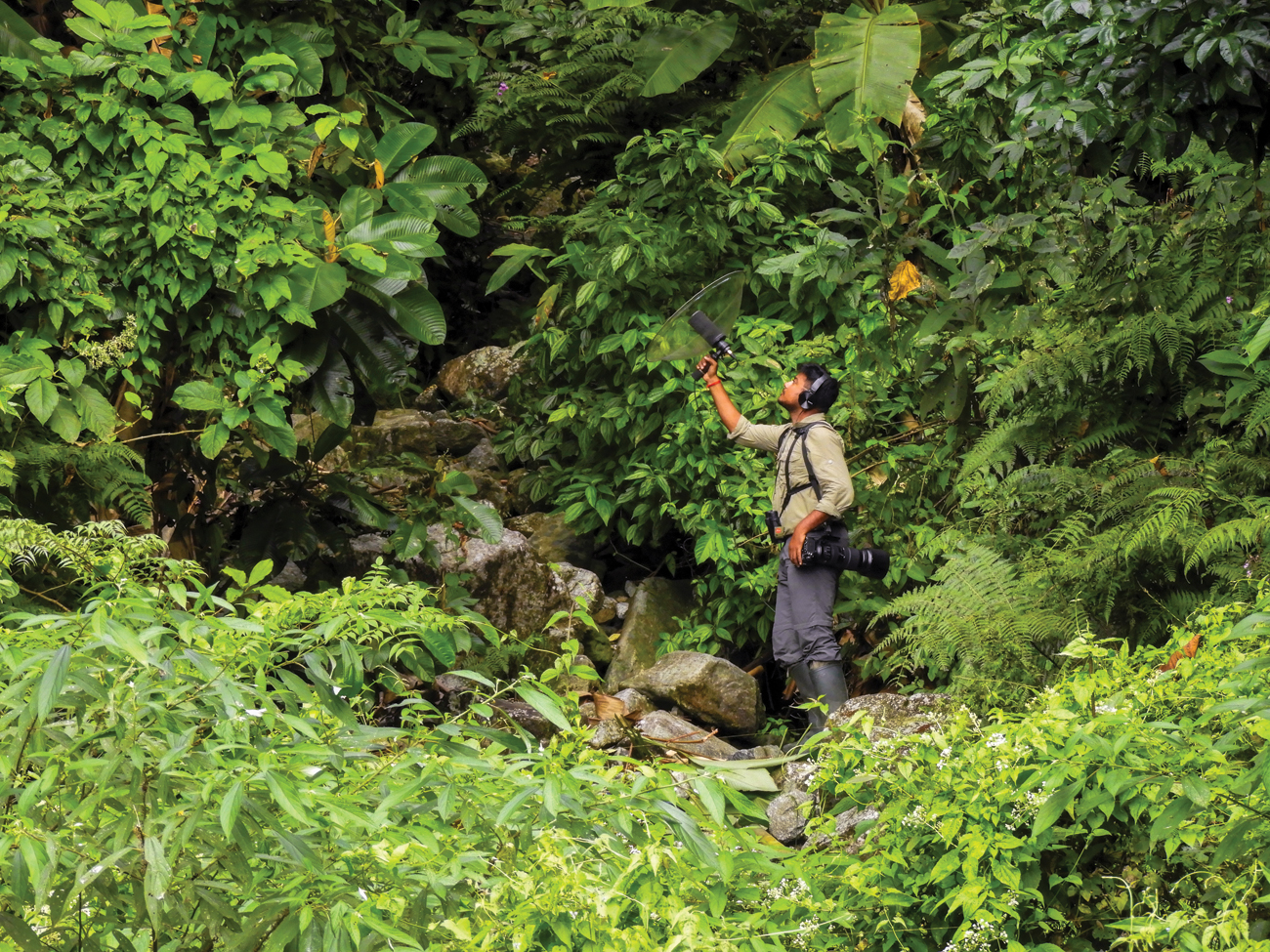
Naturalist, wildlife photographer and filmmaker, Saurabh Sawant uses a parabolic microphone to collect sound data in Mishmi, Arunachal Pradesh. Scientists use ecoacoustics to monitor ecosystem health by studying the “acoustic signatures” of natural environments. Photo Courtesy: Saurabh Sawant.
Digital Conservation Revolution
For much of the last century, naturalists built their understanding through field notes, specimens, sketches, and tape recordings. These foundations remain invaluable, but they were slow and patchy. The digital era brought GPS units, satellites, and motion-triggered cameras. Citizen science platforms such as eBird and iNaturalist multiplied the reach, harnessing millions of observers. In the last five years, AI and machine learning have entered the field directly.
This shift, from field notes to algorithms, from memory to machine learning, captures something larger. For instance, while examining shapefiles for eBird filter maps recently, I noticed how they are moving from rigid square grids to flexible hexagons that can be linked into polygons. For decades, scientists relied on squares because they were simple to compute and easy to scale, even though they distorted neighbourhoods and distances. Hexagons, with six equal neighbours, offer a truer reflection of how landscapes actually connect. They are harder to calculate and more difficult to scale, and until recently were impractical to apply. But as processing power and AI grow, the shape of our maps is beginning to echo the shape of the land itself.
Merlin’s Sound ID can now identify hundreds of Indian birds by their calls. BirdNET can comb through thousands of hours of audio in minutes, revealing nocturnal species that evade the eye. Raven Pro remains the precision tool for detailed analysis. Arrays of autonomous recorders now listen across reserves. If deployed in the scrublands of Andhra Pradesh, such arrays could perhaps detect the faint nocturnal call of the Jerdon’s Courser. With machine learning models trained to filter out insect buzz, wind, and village noise, rediscoveries that once seemed impossible may yet occur.
Vision is evolving too. iNaturalist’s computer-vision model recognises over 100,000 taxa worldwide, learning more with each uploaded photograph. Swarovski’s AX Visio binoculars put recognition directly in the hands of birders. AI-assisted camera traps such as TrailGuard, already in use in India, detect humans, vehicles, and animals on-site and send instant alerts to rangers. These devices shrink the distance between event and response, sometimes to a matter of seconds.
The effect is visible across India. Uttar Pradesh’s Forest Department is constructing an Integrated Forest Management System with drones, AI cameras, GPS patrols, and satellites linked to a central command centre. In Haryana’s Sultanpur National Park, drones and cameras are being readied to monitor migratory birds. In Jharkhand’s Kolhan division, drones scatter seed balls made by women’s self-help groups across inaccessible slopes, replanting native species. In Similipal, AI camera traps have helped authorities identify poachers. In Kaziranga, acoustic monitoring reveals the voices of grassland species with minimal intrusion. In Uttarakhand and the Thar desert, vultures and raptors carry GPS transmitters that trace their long flights, exposing the threats of poisoning and power lines.
Beyond India, the frontier stretches wide. In the United States, AI models forecast whale habitats to help ships steer clear. Across Africa, TrailGuard AI cameras transmit real-time alerts when elephants or intruders appear. Drone surveys are routine in seabird colonies in the Arctic and along crocodile rivers in South America. Coral reefs in the Pacific are analysed with AI trained to detect bleaching from satellite and underwater imagery. BioTrove, built from millions of iNaturalist images, is training models to recognise even rare and cryptic species.

During the training of forest guards in the Ranthambhore Tiger Reserve, Sanctuary Nature Foundation’s Dr. Parvish Pandya demonstrates the use of technology to record sightings on the mobile phone. Photo: Govardhan Meena.
New Frontiers In Field Biology
The possibilities for rediscovery extend further. The Himalayan Quail, last seen in 1876, could be searched for with arrays of recorders in the hilly grasslands of Uttarakhand, coupled with thermal drones at dawn and dusk. The Pink-headed Duck, missing since 1949, might betray its presence through environmental DNA in marshes across Assam and northern Bihar. The Malabar civet, last reported in the 1990s, could reappear in AI-assisted camera trap surveys of Kerala’s coastal forests, flagged by pattern-recognition algorithms. Cryptic bats may be distinguished through full-spectrum detectors and Machine Learning-based classifiers. Hydrophone networks along the Ganga and Brahmaputra are beginning to track the clicks of Ganges river dolphins and could also reveal the movements of fish such as the hilsa. Such possibilities remind us that what is lost may not always be gone, only waiting for the right tools to reveal it again.
Technology is also entwined with climate change, which shapes every conservation question.
Satellites already track glacial retreat in the Himalaya, drones measure snowpack, and LiDAR maps forest biomass. AI models link species ranges with rainfall and land-use patterns to forecast future habitats. Remote sensing helps monitor mangroves that buffer coasts from cyclones. Citizen-science photographs document flowering and fruiting times, building phenology records that show shifts in response to warming. Early warning systems for floods and cyclones, built on AI weather models, help communities near the Sundarban adapt. Carbon mapping through remote sensing guides reforestation projects critical for India’s climate pledges. These are not abstract exercises – they directly connect to how species and people will survive the coming century.
Equally transformative is how these tools reach ordinary people. A villager records a frog call and uploads it to iNaturalist. A schoolchild identifies a warbler with Merlin. A teacher uses eBird maps to chart migration in a classroom. Regional-language apps and offline functions open participation further. When these observations flow into global platforms such as Global Biodiversity Information Facility (GBIF), alongside data from the Botanical Survey of India, Zoological Survey of India, and the Wildlife Institute of India, we gain a more complete picture of life across India’s varied landscapes.
Ethics In A Tech-Driven Future
_C-1300_1759306503.jpg)
A forest guard adjusts camera trap settings in Pakke, Arunachal Pradesh. Photo: Pranav Capila.
Yet technology carries risks. Models reflect the biases of their training data, often underrepresenting rare or remote species. False positives or negatives can misdirect action. Cameras and drones may intrude on privacy or disturb colonies. Equipment needs power and skilled maintenance, either of which are not always available in remote reserves. Permissions for drones are tightly regulated. Communities must be consulted before sensors are deployed. International frameworks such as the Convention on Biological Diversity’s post-2020 plan, and India’s Wildlife Protection Act, must evolve to reflect this new reality. Above all, technology must complement, not override, the ecological wisdom of local communities and naturalists.
Looking toward 2030, I imagine landscapes stitched together with acoustic recorders, drones, and satellites, feeding continuous streams of biodiversity data. Villages and railways receive alerts that prevent conflict with elephants, tigers and other animals. Children use apps in their mother tongues to identify frogs and bats in their courtyards. Environmental DNA reveals hidden species before they vanish. Satellite models forecast habitat shifts with climate change, guiding corridor planning. Enforcement agencies analyse online markets to disrupt wildlife trafficking. Indigenous ecological knowledge is integrated into AI outputs, producing maps trusted by scientists and villagers alike.
When I return to the forest, recorder in hand, I feel how much has changed. The pace of change is mind-boggling. Once we relied on skins and sketches. Now algorithms help us hear bats inaudible to our ears, count crocodiles from the air, detect poachers instantly, and map bird movements in polygons that better reflect the land. Yet
the essence is unchanged: to listen, to notice, to protect.
If India embraces these tools with care, sensitivity and humility, the coming decade could be one of rediscovery and renewal. Technology will not save biodiversity alone, but used wisely it can help us protect not only what we already know, but also what we have not yet imagined. In the end, the forest is always speaking.
The technology is ready. The future of conservation may simply depend on us asking the right questions – all we need is the right prompt!
Unprecedented Discoveries
A Record-Breaking Year For India
India is home to an astonishing seven to eight per cent of all recorded species on Earth, despite occupying just 2.4 per cent of the planet’s land area. The country’s geographic richness underpins its exceptional species diversity, which includes four of the world’s 34 recognised global biodiversity hotspots. Encouragingly, the number of newly described flora and fauna in the country continues to grow, thanks to dedicated fieldwork, scientific research, and the increasing involvement of citizen scientists.
The Zoological Survey of India (ZSI), operating under the Ministry of Environment, Forest and Climate Change, plays a vital role in documenting India’s faunal diversity to inform conservation and management efforts. Since 2008, ZSI has published Animal Discoveries of India: New Species and New Records, an annual volume compiling information on newly described species and new records from India.
In 2024, India recorded a total of 683 new faunal discoveries, which is the highest number documented in a year since formal recording began in 2008. This includes 459 species newly described to science, 224 species recorded in India for the first time, and 22 newly established genera. Kerala recorded the highest faunal discoveries, of 101 species – 80 newly described and 21 newly recorded for the state. It was followed by Karnataka with 82 species, Arunachal Pradesh with 72, Tamil Nadu with 63, West Bengal with 56, the Andaman and Nicobar Islands with 43, Meghalaya with 42, and Uttarakhand with 31. On the other end of the spectrum, the fewest discoveries were reported from Chandigarh, Delhi, Haryana, and Telangana.
The total number of faunal discoveries stood at 641 in 2022 and rose to 662 in 2023. The cumulative number of species and subspecies recorded by ZSI scientists since its establishment in 1916 is now 105,244. Despite the challenging conditions faced by the country’s biodiversity today, including rapid habitat loss, increasing pollution, and the impacts of climate change, these new discoveries serve as a reminder of what is at stake and how much may disappear before we even have the chance to identify it.
Reference: Animal Discoveries of India: New Species and New Records, Zoological Survey of India
Lost And Found
New Hopes In Least Explored Landscapes
By Zeeshan Mirza
In recent years, there has been a sharp rise in the number of newly described reptile species in India. Most of these discoveries have come from the Western Ghats and, to a lesser extent, Northeast India. Yet researchers across the country are now exploring lesser-studied regions and uncovering not only new species but entirely new genera. Among these is the Western Himalaya – long overlooked and often considered less biodiverse, thought to harbour only a subset of the Eastern Himalaya’s species. However, focused fieldwork has challenged this view.
A recent breakthrough from Himachal Pradesh led to the discovery of both a new species and genus: DiCaprio’s Himalayan snake Anguiculus dicaprioi. Its close relative, Rapp’s Himalayan snake Anguiculus rappii, occurs in the Eastern Himalaya, highlighting a recurring pattern of east-west divergence seen across several taxa. Emerging DNA studies in reptiles and arachnids are beginning to reveal this biogeographic divide more clearly.
Other important finds in the Western Himalaya include the black-bellied coral snake Sinomicrurus nigriventer and the Churah Valley kukri snake Oligodon churahensis, further underscoring the region’s unique biodiversity. Similarly, research along the Indo-Burma border has brought to light numerous new species of bent-toed geckos Cyrtodactylus, along with endemic snakes such as the Mizoram rain snake Smithophis mizoramensis and the banded rain snake Smithophis leptofasciatus.
There is little doubt that more work in these underexplored areas will result in further discoveries. Yet, significant challenges remain – chief among them, the long and complex process of obtaining research permits. While states such as Kerala, Karnataka, Himachal Pradesh, and Arunachal Pradesh have more streamlined, researcher-friendly systems, many others take over a year to respond, or worse, deny permits altogether. This greatly hinders biodiversity documentation and delays critical conservation work.
At the same time, securing research funding has become increasingly difficult. For biodiversity science to flourish, it is essential that state Forest Departments across India support researchers and enable fieldwork in a timely and transparent manner. Facilitating access to field sites is a foundational step toward conserving both species and their habitats.
The Western Himalaya and several other Indian landscapes remain among the least explored biodiversity regions. Tragically, the window of opportunity to study them is closing fast. As you read this, habitat destruction continues to erode fragile ecosystems, driven by development and its ripple effects. Initial losses from infrastructure expansion have been compounded by secondary threats such as fragmentation, pollution, and climate change.
Protecting India’s rich natural heritage demands a shared commitment. Researchers, Forest Department staff, policymakers, journalists, and local communities all have a role to play. When each does their part, and more importantly, when we work together, conservation becomes more than just an ideal; it becomes possible.
Zeeshan A. Mirza is a biologist based at the Max Planck Institute for Biology, Germany. He is interested in the study of reptiles and arachnids of Asia.
A Glimmer Of Hopes
India’s Amphibian Discoveries
By Dr. Seshadri K.S.
Every new day, there is news of a new natural area being destroyed or diverted for some development project. The constant onslaught can be mind-numbing. News of a species being discovered or a range extension of a species being reported is often perceived to be the much-needed antidote.
Over the last quarter of a century, there has been a phenomenal increase in the number of amphibians being discovered in India. There are three kinds of amphibians: Anurans (frogs and toads), Gymnophiona (caecilians), and Caudata (salamanders). A whopping 462 amphibians find a home in the diverse landscape of India. This amounts to approximately 4.7 per cent of the global amphibian diversity. Often referred to as the Indian subcontinent, the country has a rich biogeographic history and a complex evolutionary history. The landmass broke off from Gondwana land and rafted across the ocean and collided with the Asian landmass, creating the mighty Himalaya. During this long process, species of the family Nasikabatrachidae have rafted along with it, while those in the family Rhacophoridae have evolved into a rich diversity of species, occupying a variety of niches.
Since the year 2000, a total of 246 species have been described from India. “A majority of these are anurans and a few Caecilians and overall, this amounts to nearly 10 species per year,” said Prof. Gururaja K.V. These discoveries are a cumulative consequence of more people pursuing herpetology, examining the species critically, and using an integrated taxonomic approach that moves beyond traditional morphology to include aspects such as genetic comparisons, acoustics, and computer tomography (CT) scanning. Many of these species have been described by Prof. Gururaja and his team, based at the Srishti Manipal Institute of Art and Design, Bengaluru.
While new species continue to be described from the rich forested landscapes of the country, many are increasingly being described from human-dominated areas. While this can be a source of inspiration that discoveries can be made everywhere, it points to a larger, deeper concern. We know very little about the threats faced by these species, especially in human-modified landscapes. Globally, amphibians are among the most threatened vertebrates, with two out of five species facing the threat of extinction. However, this high rate of discovery stands in stark contrast to India’s poor knowledge about these species, a situation Prof. Gururaja calls a ‘dubious distinction’.
Discovering a new species is often a painstaking process. It begins with carefully observing the amphibian, often in its natural setting, and comparing characters to previously described species. Given that photographs are often not sufficient, researchers collect a few specimens to be able to preserve them and designate one of them as the ‘Holotype’. This process, while cruel-sounding, is strictly regulated, both by the Wildlife Protection Act, 1972, and the Prevention of Cruelty to Animals Act, 1960. Animal ethics committees mandate that the researchers minimise collections to as few as possible. All individuals collected are photographed and humanely euthanised by the application of topical anaesthetics such as Benzocaine or MS-222 (Tricaine methanesulfonate). The authors are at liberty to choose what they want to name the amphibian, and often they name it after the region where it was found. For example, a recently described tree frog, the Patkai green tree frog, gets the scientific name Gracixalus patkaiensis.
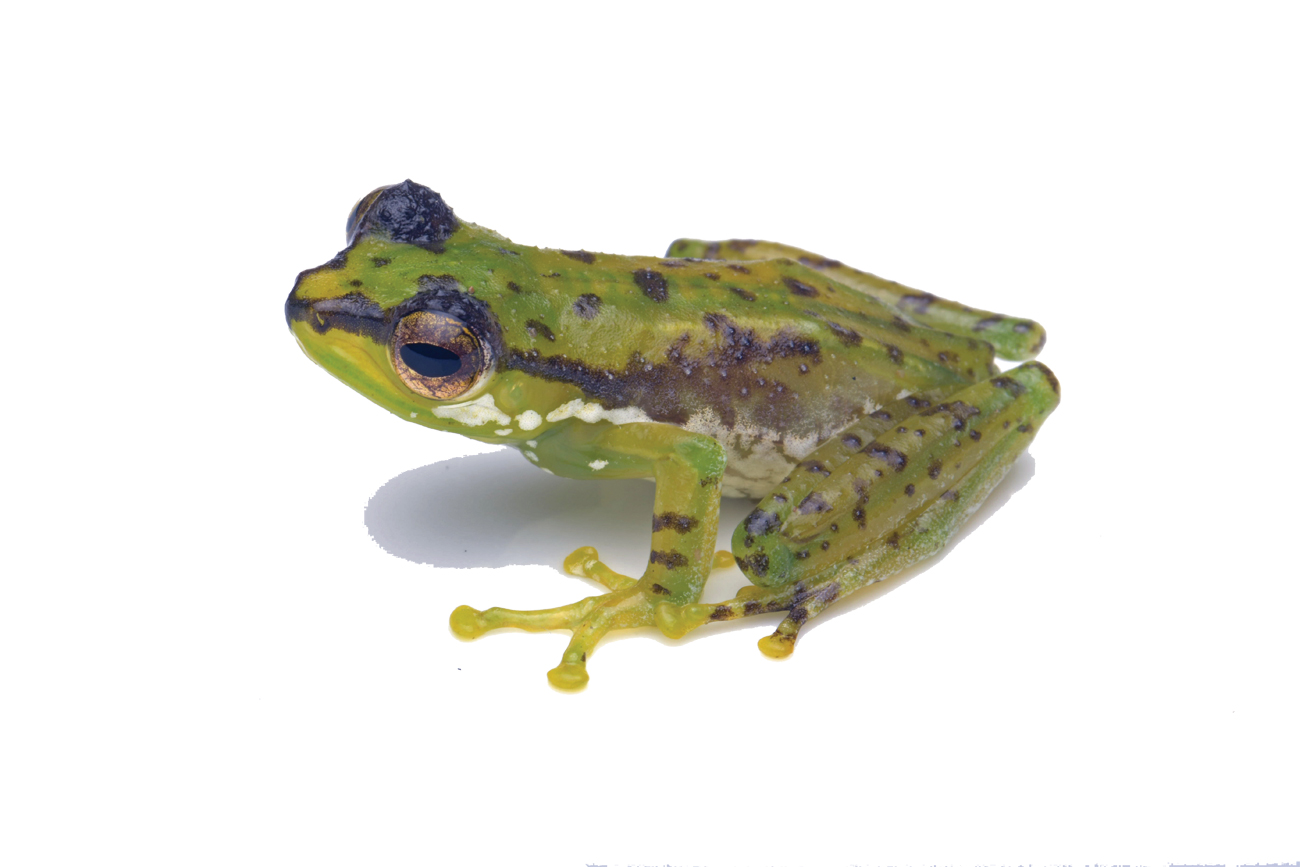
Patkai green tree frog Gracixalus patkaiensis. Photo: Abhijit Das.
Entry into forest areas requires prior research, a collection permit, and clearance from the Institutional Animal Ethics Committee, in the researcher’s host institution. The collected specimens also need to be deposited in a national museum, such as the one in the Bombay Natural History Society (BNHS) or any of the regional centres of the Zoological Survey of India. Having done all this, researchers often spend several weeks or months in the lab sequencing DNA, measuring the specimen under a microscope, and drafting the manuscript, which goes out to subject matter experts for review. If there are no glaring concerns, the manuscript is accepted and published in a journal. It is only after this process that researchers declare that a species has been discovered and described.
Every year, organisations compile lists of new species being described in the preceding year. While this is an essential exercise that fills us with pride, it is also something for us to pause and critically reflect upon. With every new species being discovered, we are learning something new about the natural world. We seem to take so much of nature for granted, and yet, there is something new to be discovered. Often, when papers with new species are described, there is a section called natural history and ecology. Unfortunately, this is often the smallest section with the least amount of information. It is likely that in the race to describe the frog or caecilian, researchers often don’t spend the prolonged period required to understand the species and its ecology.
In a few cases where researchers have done so, they have not only discovered new species but also documented novel behaviour such as parental care in frogs that breed in bamboo or the curious case of the potter frog, which delicately covers its eggs in mud. Many of these observations lead us to profound insights into the life of the animal and our shared evolutionary history. From a scientific lens, describing a species makes one part of scientific history. Years from now, for as long as scientific enterprise exists, author names are tied to that of the species. For some, it gives a sense of immortality. But it is important to remember that this immortality came at the cost of an animal that simply does not care what it is called!
Dr. Seshadri K.S. is a faculty member at ATREE. An ecologist by training, he now studies diverse ecosystems, including frogs. He has described three new species of frogs and novel behaviour among amphibians in the Western Ghats.
An Unexpected Discovery
When Observations, Geography And Funding Mix
By Sandeep Das
Korakkokkk, korakkokkk, korakkokkk. The loud, persistent calls had been a constant companion, pounding in my ears for thousands of kilometres over the last couple of days. We were deep in the Western Ghats, on a mission to survey for the presence or absence of the Mahabali frog Nasikabatrachus sahyadrensis.
Following their calls is a brief, intense window of opportunity. These elusive frogs spend almost their entire lives underground, emerging for just one day each year to breed. After that short-lived chorus, our surveys would depend entirely on finding their tadpoles, which inhabit seasonal streams for 100 to 130 days before they transform.
Despite the long hours of continuous driving and exhausting night surveys, we were fuelled by the excitement of discovering multiple new locations for the species. This was my first field season for the EDGE project focused on conserving the purple frog, and every new finding was a testament to our efforts.
One afternoon, in Idukki, we were scouting for streams. It was sunny, but the tall trees of the evergreen forest provided welcome relief. As we walked toward a promising stream near a roadside bus stop, we saw a brief flash of something tiny darting through the leaf litter, but couldn’t make out what it was. Our focus remained on the stream, which, unfortunately, had very little water and no evidence of breeding.
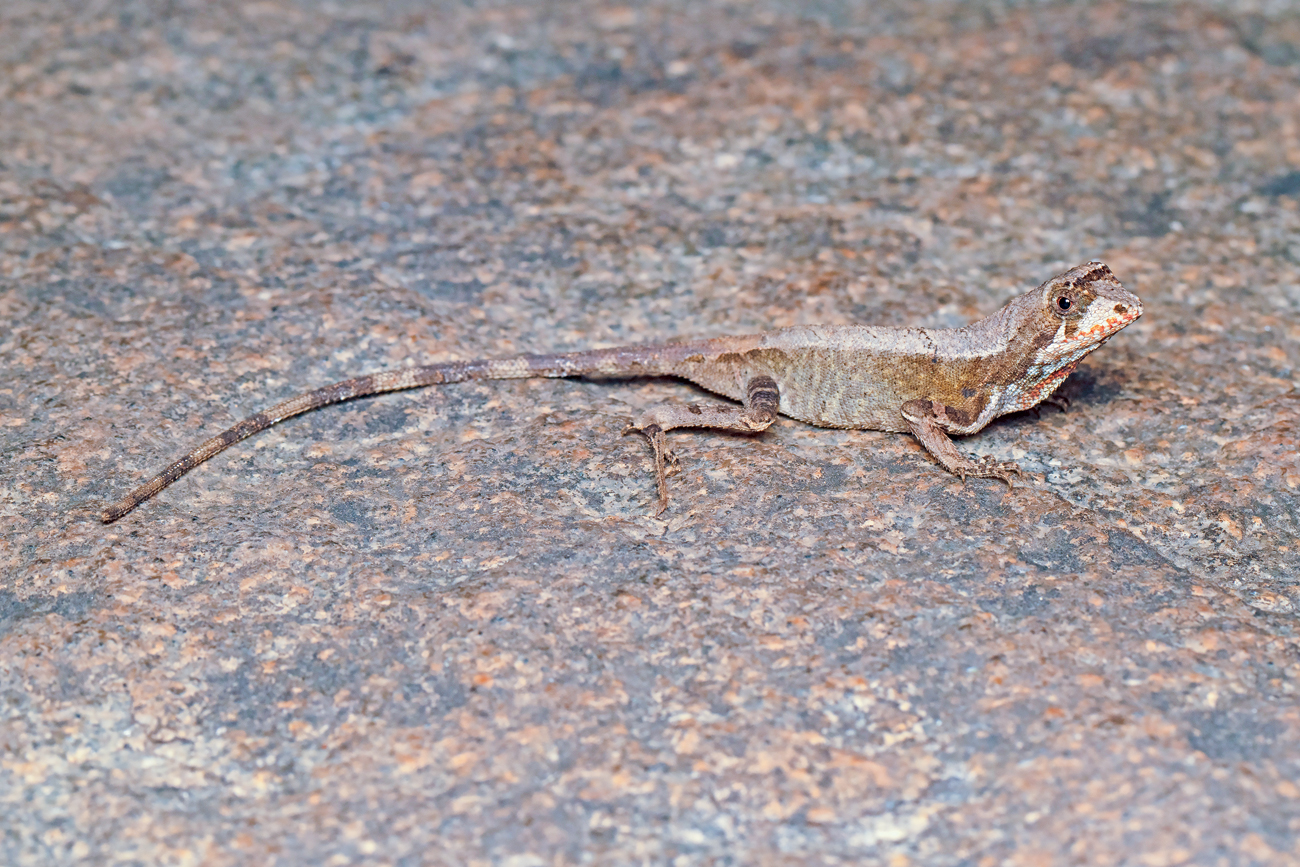
This male northern kangaroo lizard Agasthyagama edge, is a cryptic, ground-dwelling lizard endemic to the Western Ghats and seldom observed in the wild. Photo: Dr. Sandeep Das.
As we were walking back, a tiny lizard suddenly ran on its hind legs, like a miniature velociraptor. “Kangaroo!” I yelled in joy. It was a kangaroo lizard Agasthyagama beddomii, known for its swift, bipedal escape strategy, which likely earned it its name. Although I had seen them many times in the Agasthyamala landscape, this sighting was totally unexpected and thrilled us all. We found two more at the same spot before leaving for our next survey location.
At the time, we didn’t realise that this ‘kangaroo lizard’ was a completely new species. It was only later in 2019, while casually sharing field stories with our long-term collaborator Deepak V., that he suggested the possibility that this lizard might be different from Agasthyagama beddomii owing to its geographic separation.
This led us to follow it up in detail. While Deepak examined specimens at the Natural History Museum London and the Chicago Field Museum, we studied those in India, including Dr. Jafer Palot’s collection. Subin, one of our co-authors, found more locations during his Ph.D. work on plants in the area. We also conducted detailed morphological and genetic analyses.
After this comprehensive, integrative study, we concluded that it was indeed a new species. While they looked similar, our investigation revealed several differences, including a distinctive yellow colouration on their gular (throat) region.
Our initial sighting of the lizard occurred during my EDGE project. In recognition of the programme’s global efforts to conserve and research Evolutionarily Distinct and Globally Endangered species, we decided to name it Agasthyagama edge after the Zoological Society of London’s EDGE programme.
Like this one, countless other species likely remain undiscovered or unnoticed, waiting to be studied and understood.
Dr. Sandeep Das is currently pursuing his second post-doctoral position as a Research Associate with the Department of Biotechnology, Government of India, and is also a seasoned wildlife photographer.
Pallas’s Cat In Arunachal
A Glimpse Into India's Hidden Highlands
By Dr. Rishi Kumar Sharma
Earlier this year, as part of our efforts to understand and conserve Arunachal Pradesh’s high-altitude ecosystems, our camera traps captured something truly extraordinary. At nearly 5,000 m. above sea level, we recorded the first photographic evidence of the Pallas’s cat Otocolobus manul in the state. For me, as someone who has worked in the Himalaya for years, this single image carries immense weight – it places Arunachal firmly within the global range of a species so rarely seen in India, and it demonstrates just how much remains undiscovered in these remote landscapes.
The Pallas’s cat is a small, stocky feline, instantly recognisable by its thick fur and striking face. Known mainly from the cold steppes of Central Asia, it has been sporadically documented in Ladakh and Sikkim. Its confirmation in Arunachal extends our understanding of how connected the Himalayan arc is for such elusive carnivores, and offers new insight into the resilience of wildlife at the highest elevations. For conservationists like me, every such discovery is both a scientific milestone and an emotional reminder of the fragility of these frontiers.
This record emerged from a year-long survey we are leading in the Western Arunachal Landscape. Between July 2024 and July 2025, our team deployed 138 camera traps across 83 locations, covering more than 2,000 sq. km. of Tawang and West Kameng districts. The aim is to monitor snow leopard populations and their prey, but in doing so we are uncovering a much larger story of biodiversity that thrives at elevations between 4,000 and 5,500 m.
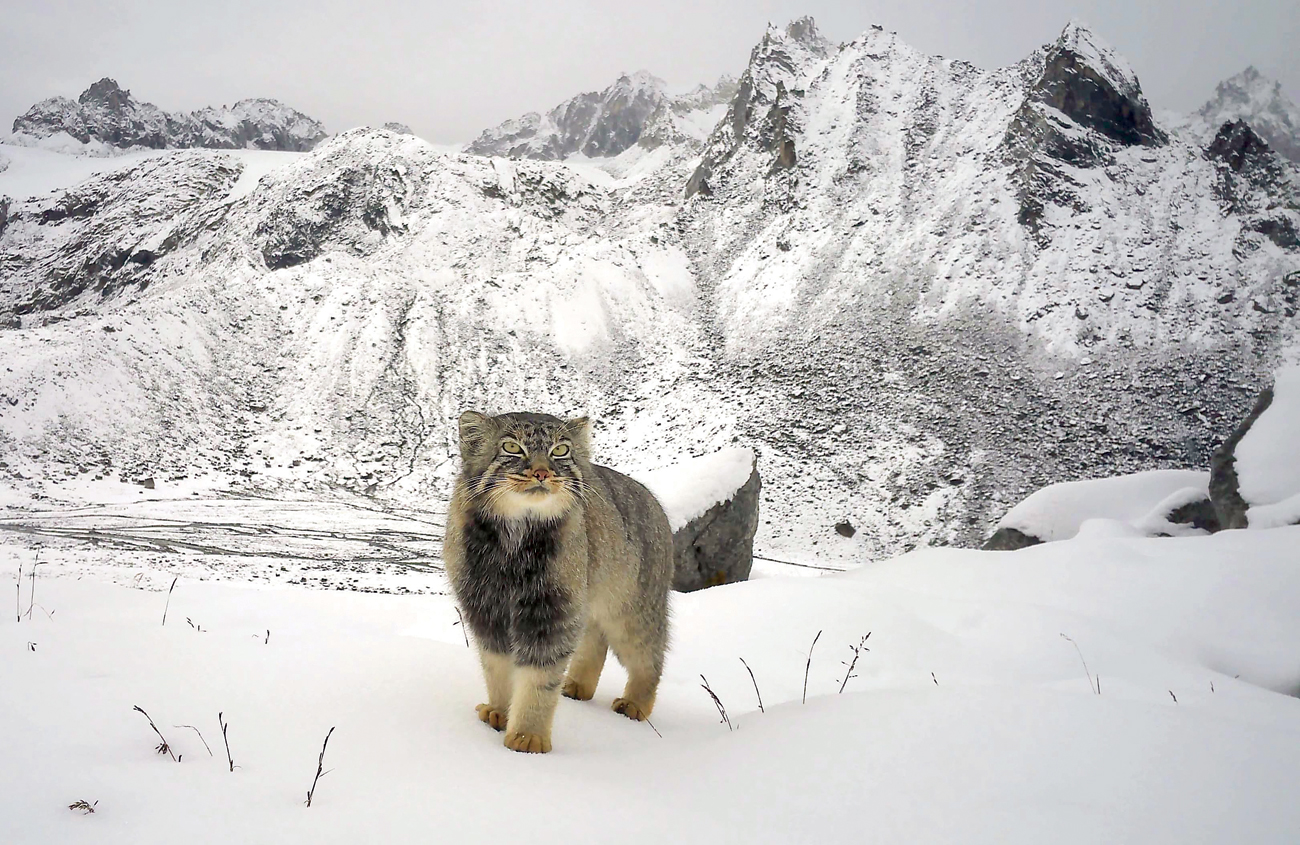
Photo: WWF-India.
Already, the findings have been remarkable. We have documented 31 species so far, including four new elevation records for wild cats. A marbled cat Pardofelis marmorata appeared at 4,600 m., far above its previously known range. A clouded leopard Neofelis nebulosa showed up at 4,194 m., and a common leopard was recorded at 4,326 m. in the same location as a snow leopard and a marbled cat – a rare glimpse into high-altitude carnivore co-occurrence. Each of these records pushes the boundaries of what we know about these species and challenges long-held assumptions about where they can persist.
Our cameras have also captured the ungulates that sustain these predators: blue sheep, Himalayan goral, musk deer, and serow. We have images of mountain weasels and stone martens, as well as the brilliant Himalayan Monal, Blood Pheasant, and Snow Partridge. These encounters remind me of how layered these ecosystems are, each species linked to another in a delicate balance shaped by climate, terrain, and human presence.
Yet the survey has also revealed threats. We have documented wildlife entangled in wires, free-ranging dogs chasing wild ungulates, and incidents of livestock predation. These challenges are a sobering reminder that conservation here must engage deeply with local communities, whose livelihoods are interwoven with the same landscapes. Without their stewardship, no monitoring or scientific record will translate into meaningful conservation.
The Pallas’s cat may be the headline, but the true significance lies in what these findings collectively tell us: that Arunachal’s highlands are alive with hidden life, fragile connections, and urgent conservation needs. Every frame from our cameras represents a small step toward protecting this extraordinary frontier, where science, culture, and nature must come together if we are to secure its future.
Dr. Rishi Kumar Sharma is Head-Science and Conservation, Himalayas Programme, WWF-India.
Insect Insights
Discovery, Decline And The Future Of Taxonomy
By Seena Narayanan Karimbumkara & Priyadarsanan Dharma Rajan
“What’s in a name?” Shakespeare asked. Yet without names, we risk overlooking the very essence of what we seek to understand. Discovering a new species is more than just naming a species; it’s the gateway to studying its habitat, behaviour, evolutionary history and ecological role. Over the past five years, researchers at ATREE’s Insect Biosystematics and Conservation Laboratory have described 29 species of parasitic wasps (including four new genera), one potter wasp, seven ants, three bugs and three dung beetles – insect groups that are key players in ecosystem health. The Zoological Survey of India’s 2024 publication Animal Discoveries echoes this trend: insects accounted for the majority of new species, with 247 species across 15 orders and 67 families. Hymenoptera led the list with 121 species, followed by 34 moths, 24 beetles, and 23 species each of flies and true bugs. Yet, vast numbers remain undiscovered and unnamed, especially in underexplored landscapes, waiting for science to catch up.
Though Animal Discoveries documents 247 new species of insects, only 147 new records were reported from India in 2024. This disparity highlights a concerning trend among taxonomists, who tend to prioritise publishing new species descriptions and occasional taxonomic revisions while showing little interest in compiling authentic checklists. Taxonomists should focus on publishing comprehensive checklists and systematic taxonomic revisions to illuminate the true diversity of the landscapes they explore. The geographic distribution of the newly discovered species highlights gaps in collections. Most were recorded from biodiversity hotspots such as the Western Ghats and Northeast India – regions recognised as rich in biodiversity, yet still underexplored. In contrast, vast stretches of Central India and the arid western plains remain poorly surveyed. The patterns of discovery point to the gap of neglecting lesser-known orders and families in taxonomic studies. The coverage of discoveries to certain insect orders, Hymenoptera (wasps and ants), Coleoptera (beetles), and Diptera (true flies) dominate, largely owing to the presence of active taxonomic expertise. This reflects a shortage of specialists and uneven allocation of research attention and funding.
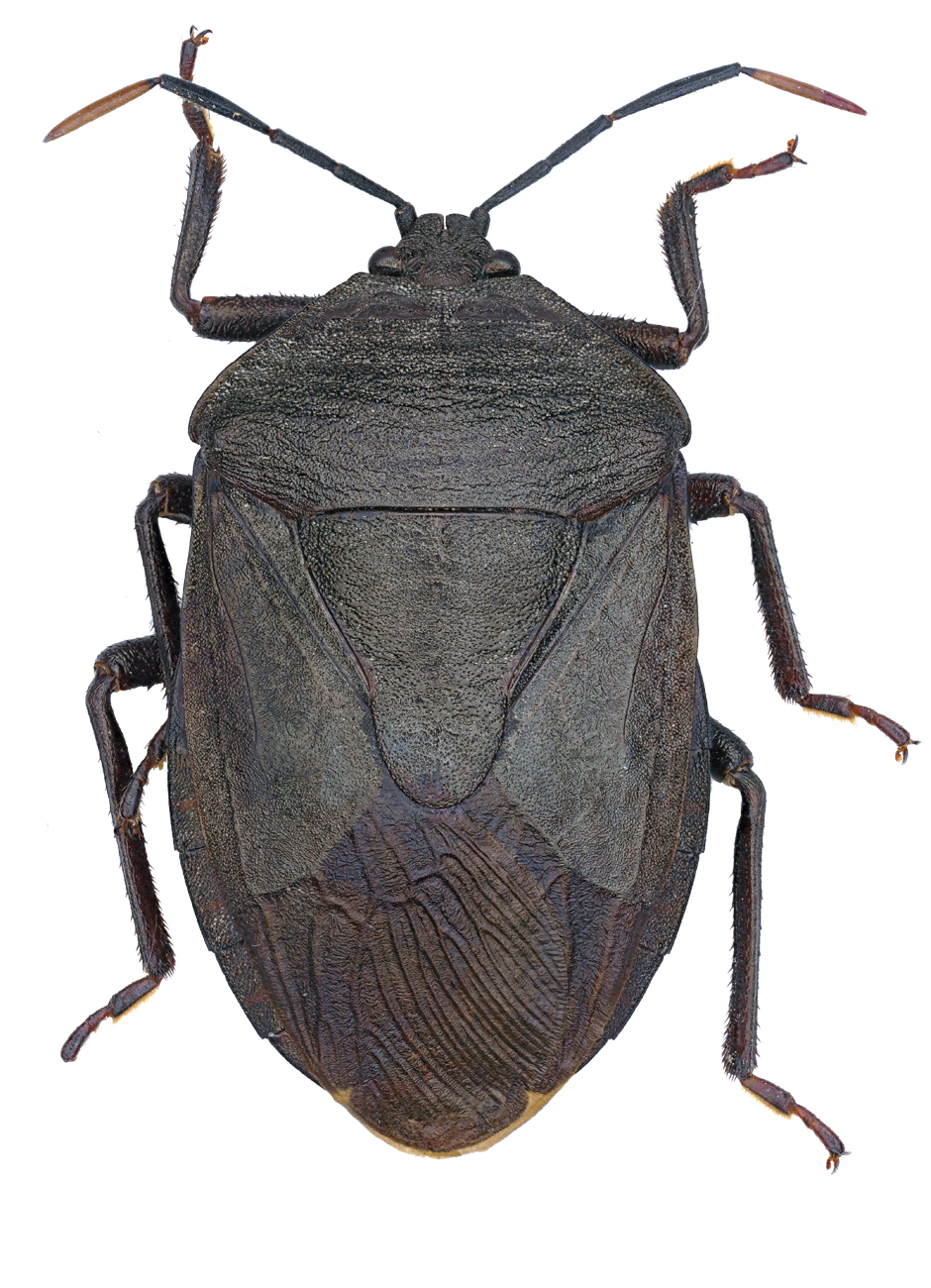
A new species of stink-bug Coridius esculentus; a traditional delicacy among the ethnic communities in Arunachal Pradesh. Consumption in large quantities can be neurotoxic. Photo Courtesy: ATREE.
There is also a critical gap in the ecological information available on the newly described species. Many have been described solely on the basis of morphology, with little understanding of their habitats, life cycles, or ecological functions. Without such knowledge, conservation planning cannot move beyond names. Linking taxonomy with ecology, genomics, and citizen science is urgently needed to bridge this divide. The landscapes from which the new species were discovered are under increasing threat from deforestation, infrastructure development, monoculture plantations, and mining. Climate change compounds these pressures by altering microhabitats and shifting species distributions. Insects such as katydids and dung beetles, which are highly sensitive to vegetation changes and soil disturbance, are particularly vulnerable. Newly discovered species with narrow ranges – for example, a new species of ant described from the Siang Valley of Arunachal Pradesh is restricted to that landscape or beetles restricted to a small forest patch – may face extinction even before their ecological roles are fully understood.
The insect discoveries of 2024 in India, highlight both promise and peril. They reaffirm that our country harbours extraordinary biodiversity. But they also signal that time is short. Closing the knowledge gaps – geographic, taxonomic, and ecological – while addressing threats from habitat degradation and climate change is vital. Expanding research networks, training new taxonomists, and integrating conservation into development policies will be key to ensuring that today’s ‘new’ species do not become tomorrow’s forgotten losses. Today, the world has acknowledged a global decline in insect diversity driven by developmental pressures and climate change.
Equally concerning is the shrinking number of trained taxonomists and the decline of taxonomic institutions, as taxonomy continues to disappear from university curricula and research departments. To confront this challenge, taxonomy must evolve into a more collaborative and integrated science. Insect taxonomy today is no longer a standalone pursuit but a part of biosystematics – an interdisciplinary field that combines explorations, natural history, cybertaxonomy, genomics, phylogenetics, and quantitative methods. To maximise its impact, taxonomists should work together across institutions and countries, pooling expertise, data, and infrastructure. National and international collaborations can enable joint surveys, standardised protocols, shared digital repositories, and training programmes for the next generation of taxonomists. By linking traditional taxonomy with modern tools and fostering open networks, scientists can better address large-scale questions of evolution, ecology, and conservation while ensuring that taxonomic knowledge remains a living, expanding discipline.
Seena Narayanan Karimbumkara and Priyadarsanan Dharma Rajan work with the Insect Biosystematics & Conservation Laboratory, Ashoka Trust for Research in Ecology and the Environment (ATREE).
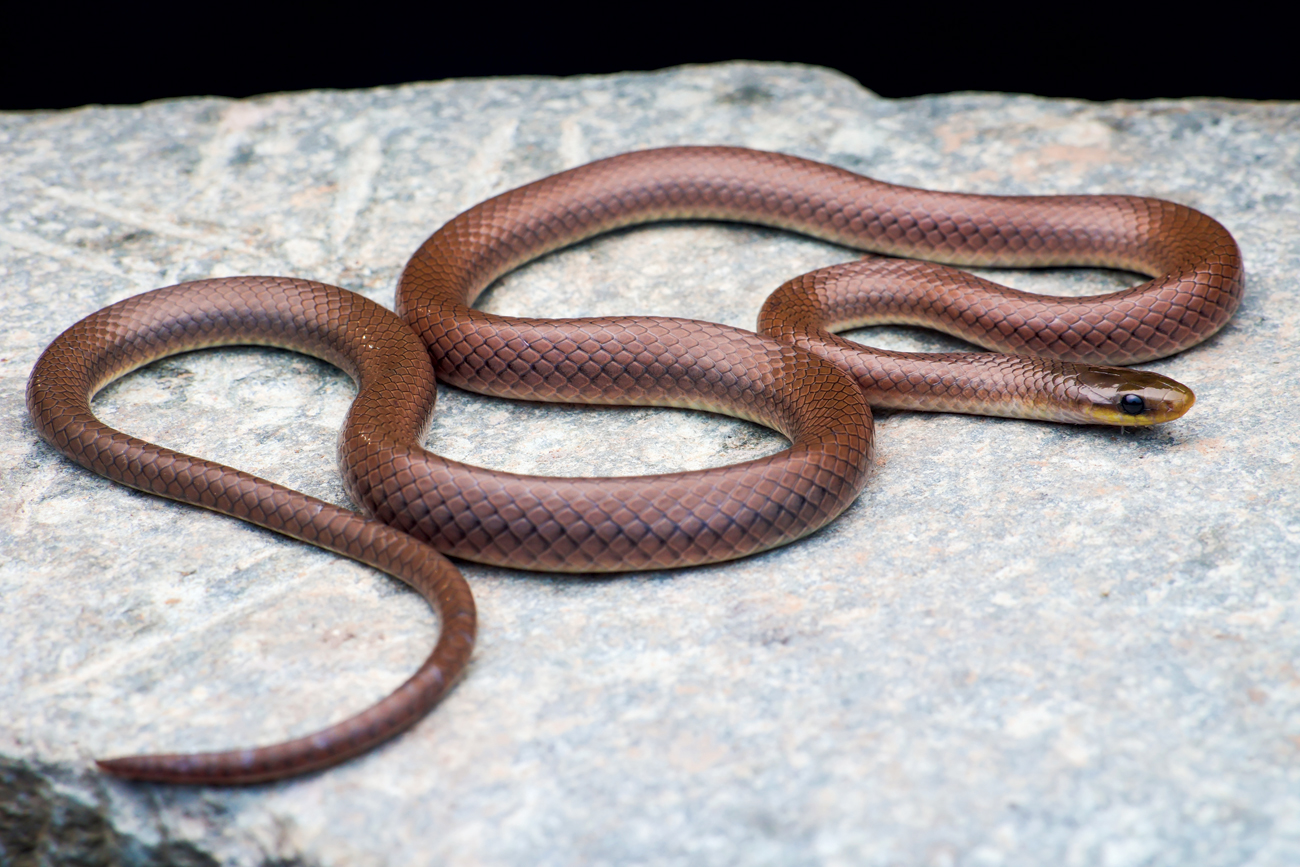
A newly described colubrid snake DiCaprio’s Himalayan snake Anguiculus dicaprioi was named after American actor and environmental supporter Leonardo DiCaprio. Photo: Virender K. Bhardwaj.
What Is A Species?
The Discovery Is In The Details
By Karmannye Chaudhary
In school, we are taught that a species is a group of organisms that can breed and produce fertile offspring. However, many organisms reproduce asexually, some hybridise, identical-looking specimens differ genetically, and the same species can have multiple names.
It’s long been debated by scientists that the species concept is ambiguous, and this ‘species problem’ shows that it is partly a human construct to help make sense of life. Despite this ambiguity, describing a species still matters as it reveals an organism’s identity, its role in nature, and the steps needed to conserve it.
The discovery of a new species is often part luck, part patience, and the process of describing it can be anything from thrilling to tedious. It often starts on a field expedition, though discoveries can be accidental – in my case, it was my mother who found one dead on a windowsill! This was a wasp of the Losgna genus, which we rediscovered in India after nearly six decades.
Once you collect a species, the real work begins. You ferry your specimen into the large libraries of reference collections (often housed abroad from colonial-era collections such as the Natural History Museum), and read every bit of literature about its group. If, after careful comparison of all available material, you can’t match it to anything, you may hold something new.
Now comes the taxonomist’s craft: a precise morphological diagnosis, measurements, diagnostic characters and comparisons, all written in the technical tongue that usually only other taxonomists recognise. Finally, there is the fun part of naming the species: a Latin binomial that might sum up the species in one word or honour a place, person, or even a beloved pet. We named our wasp Losgna occidentalis. Occidentalis signifies its western extension since the find represents the westernmost known occurrence of the genus after we rediscovered the genus, which was lost since 1965.
Once peer-reviewed by a specialist and compliant with the ICZN (International Code of Zoological Nomenclature), the species is official. It’s a long but essential process, and each species named is a voice saved from silence, a small claim on our responsibility to a world we are still learning to know.
Karmannye Chaudhary is 21-year-old biologist from Chandigarh who works on waterfowl, wetland ecology and rewilding in Punjab, he is a lifelong admirer of nature.
From Tekdi To Armageddon
What Two Tiny Creatures Tell Us About Our Future
By Dr. Pankaj Koparde
In the heart of Pune, where concrete spreads swiftly, the city’s hills, tekdi in Marathi, stand as quiet guardians of biodiversity. These rocky, scrub-covered slopes may look barren to the untrained eye, but they are living museums of resilient plants, birds, reptiles, and insects. It was here, on Baner Hills, that our team recently discovered a new species of jumping spider: Okinawicius tekdi. Naming it after the tekdi was both a scientific act and a cultural tribute, underscoring how important these urban natural landscapes are for wildlife.
Hills like these in Pune are not isolated examples. Across tropical cities, from India to Africa and South America, similar patches such as scrub-grasslands, rocky plateaus, wetlands, or wooded ridges form vital ecological networks. They regulate local climate, mitigate floods, store carbon, provide spaces for pollinators and seed dispersers, and offer residents the simple joy of nature close to home. Conserving these overlooked habitats is critical if our cities are to remain livable in the face of heat, floods, and biodiversity loss.
The second discovery takes us to Kerala’s Ponmudi Hills in the Western Ghats, where we described a damselfly with a name that sounds almost ominous: Protosticta armageddonia, the armageddon reedtail. Its fragile wings and shimmering body contrast sharply with the weight of its name. Armageddonia alludes to the concept of Ecological Armageddon, the alarming global decline of insect populations, sometimes called the ‘insect apocalypse’. Insects underpin ecosystems, from pollinating crops to recycling nutrients, yet studies show their numbers are plummeting worldwide.
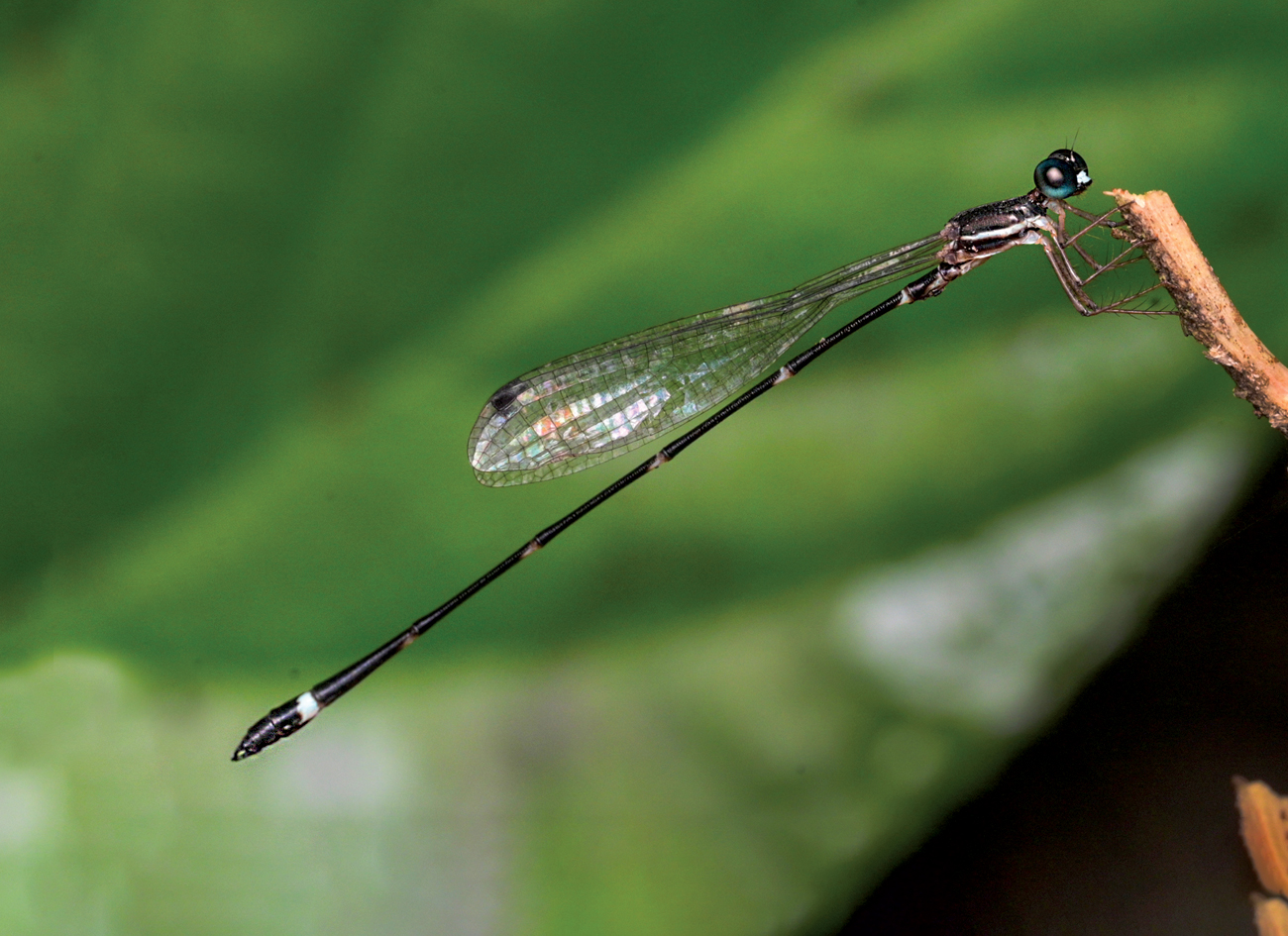
The armageddon reedtail Protosticta armageddonia, is a damselfly species in the family Platystictidae. It is endemic to the Western Ghats in India. Photo: Reji Chandran/CC-BY-SA-2.0.
By giving the damselfly this evocative name, we aimed to send a message beyond science: to policymakers, leaders, and society at large. It is a reminder that time is running out, and that urgent action is needed to reverse biodiversity loss before ecosystems collapse. Taxonomy, in this sense, is not only about naming species, it can also serve as a call to action.
The fact that both these discoveries were led by young researchers is a matter of pride and reassurance about the future of scientific discoveries – the spider discovery was led by Atharva Kulkarni, an alumnus of MIT-WPU Pune, and the damselfly discovery was led by Arajush Payra, a Ph.D. student at MIT-WPU Pune. Together, Okinawicius tekdi and Protosticta armageddonia tell a powerful story. One anchors us to the value of conserving urban green landscapes, while the other pushes us to confront a planetary crisis. Both show that every new discovery is also a responsibility: to protect, to preserve, and to act.
Dr. Pankaj Koparde is an Assistant Professor in the Department of Environmental Studies, MIT-WPU Pune.
From Binoculars To Breakthroughs
A New Era Of Bird Discovery
By Praveen J.
In India today, discoveries of birds are no longer confined to remote expeditions or academic surveys. They are happening in real time, often by ordinary birdwatchers carrying binoculars and a smartphone. A growing community of birders – citizen scientists, naturalists, and researchers alike – are reshaping our understanding of the country’s avifauna.
New records emerge from a wide range of landscapes. Some arrive from underexplored regions such as the Andaman and Nicobar Islands or Arunachal Pradesh, where surveys have historically been patchy. Others come from frontier areas such as Ladakh, where migrants from Central Asia occasionally drift across the border and surprise birders on the ground. And sometimes discoveries occur in well-birded states, where sheer intensity of effort brings new finds – Kerala’s ambitious ‘Mission 50’ is a striking example, where volunteers have already added over 30 species to the state list within just a few years. Among the last 100 new species reported from India, just these four states/UTs account for more than half of them!
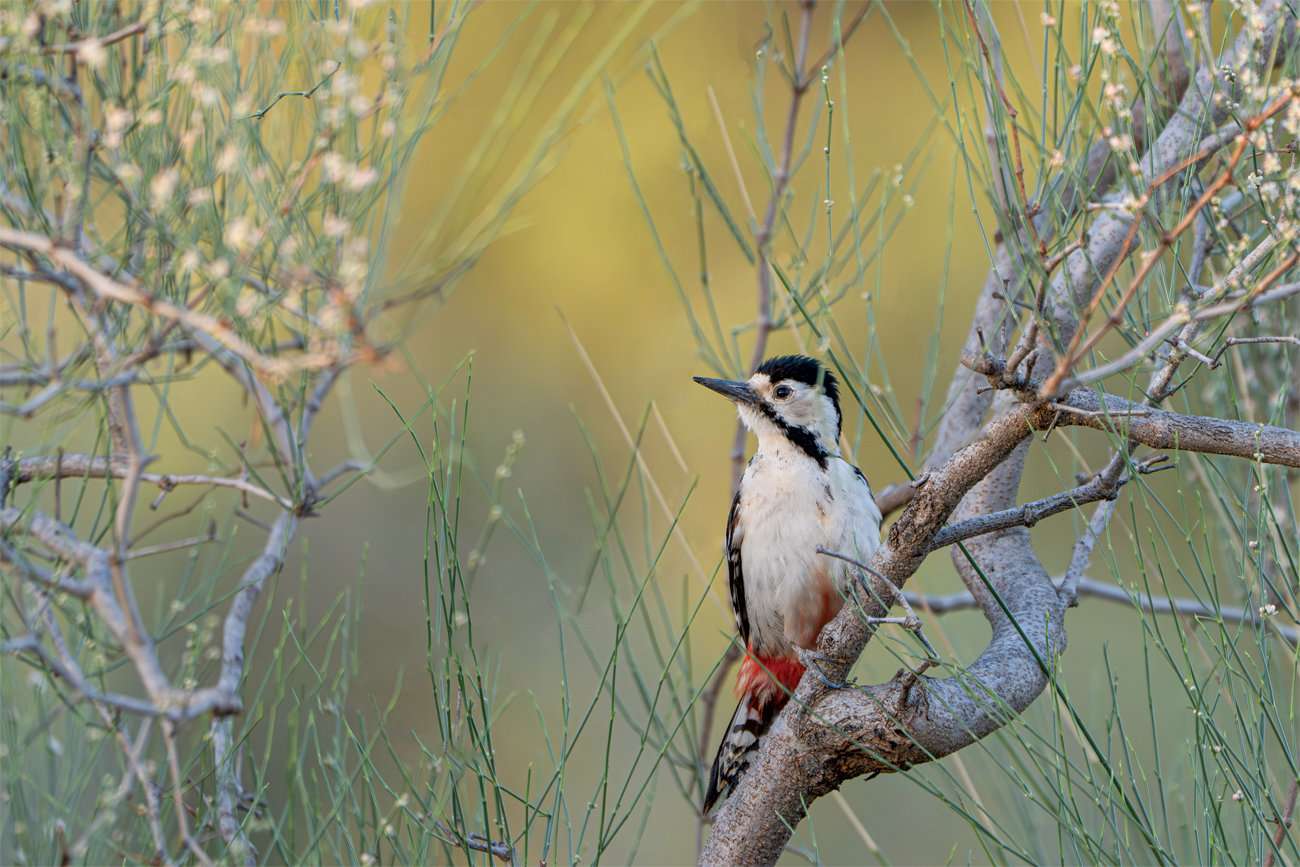
The Sind Woodpecker Dendrocopos assimilis were recently rediscovered by birdwatchers. Photo: Digvijay Singh Rathore.
Tools such as eBird have transformed these efforts. By letting birders upload photographs and sound recordings, the platform creates a permanent, verifiable record. Unusual birds are not always recognised at the time of observation. Often, a rarity may sit unnoticed in a checklist or photo archive, only to be identified months later either by the birder while cataloguing, or by an eBird reviewer spotting something odd. Now, with the rise of the Merlin app, the process has become more immediate: birders can upload a photo and receive probable identifications in seconds. This instant feedback has put expert knowledge at everyone’s fingertips, making the discovery process faster and more inclusive.
Since 2010, there has also been a surge in pelagic birding, with organised boat trips off the western coast of India. These expeditions have yielded over a dozen species never before documented in Indian waters, from shearwaters to skuas and frigatebirds. Combined with inland records, these discoveries have steadily expanded India’s national bird list, which now stands close to 1,380 species, with this year alone accounting for five new species, and is expected to cross 1,400 in just a few years.
Exploration has not only uncovered new arrivals but also helped refind long-lost species. Birds such as the Mount Victoria Babax, Sind Woodpecker, Long-billed Bush Warbler, Lisu Wren Babbler, and the near-mythical Jerdon’s Courser have all been rediscovered after years – sometimes decades – of absence from scientific records. All this is a testimony to the fact that India’s avifauna still holds secrets waiting to be uncovered.
Equally fascinating is the social ripple effect of rarities. When a rare bird is discovered, it often draws birders from across the region, who in turn find other uncommon species. This flywheel effect has been seen repeatedly: a single vagrant becomes the spark for an entire season of exploration and multiple records of rarities in an area.
_(54005895416)_C-1300_1759308414.jpg)
The Long-billed Bush Warbler Locustella major. Photo: Imran Shah/cc-by-sa-2.0.
What makes these discoveries exciting is that they are not confined to experts. A tourist in Ladakh, a landscape photographer capturing birds in a wetland, or a weekend birder scanning ducks in a village pond – all are contributing to India’s collective bird knowledge. Birdwatching has become not only a recreational pursuit but also a collaborative scientific enterprise, where each observation matters.
Ultimately, the story of bird discoveries in India is one of curiosity meeting community and technology. With eBird providing a permanent record, Merlin offering instant identifications, and hundreds of birders pushing into underexplored corners, the pace of discovery has never been higher. Each new sighting is more than a personal thrill – it is a contribution to science and a reminder that India’s astonishing birdlife is still revealing itself, species by species, checklist by checklist.
Praveen J. leads the Bird Monitoring team at the Nature Conservation Foundation. He co-maintains the bird checklist of India and edits the Indian BIRDS journal.

_(54005895416)_C-1920.jpg)



_C-1300_1759306503.jpg)







_(54005895416)_C-1300_1759308414.jpg)